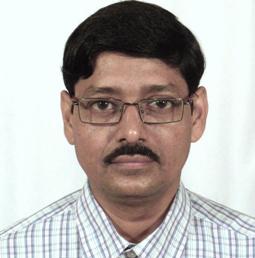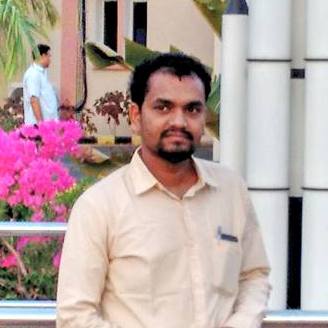Prof. Tapas Kumar Nandi

Prof. Tapas Kumar Nandi
Ph.D.(IIT Kharagpur)
Assistant Professor
T. K. Nandi joined the Institute in 2004
Contacts:
B-45, IIT Campus, Kharagpur 721302
-286729 (Office) / -286730 (Residence)
tkn_cryo @ hijli.iitkgp.ernet.in , nandi_tk@rediffmail.com
| Name | Course | Contact Number | Project | ||
|---|---|---|---|---|---|
 |
Vipin Kumar Yadav | M.Tech | 9027168019 | vipinkmr0808@gmail.com | |
 |
Karri Veerandra Yadav | M.Tech | 9444340451 | karriveerandrayadav@gmail.com | |
 |
Sudeep Kumar Gupta | Ph.D | 8768836313 | sudeepk43@gmail.com | |
 |
Mr. M. Lam Ratan Raju | Ph.D | lamratnaraju@gmail.com |
| Project Title | Type | PI/Consultant | Co-PI/Co-Consultant | Sponsor/Client |
|---|---|---|---|---|
| Design and Development of Perforated Plate Heat Exchangers for Cooling of Gaseous Helium by Using Liquid Hydrogen (DEL) | Sponsored Project | Dr. Tapas Kumar Nandi | ISRO (On-going) |
-
These heat exchangers are built by stacking high thermal conductivity perforated plates, alternately arranged with low thermal conductivity insulating spacers, and bonding them by intermetallic diffusion bonding. We have successfully fabricated several heat exchangers using the existing hot press unit available in the Centre. These heat exchangers showed no leak at a maximum pressure of 15 bar under repeated thermal cycling between 77 K and 300 K. Photograph of a heat exchanger made in the laboratory by diffusion bonding is shown below.
-

Heat Exchanger
-

Heat Exchangers
-
-
A wave expander is an unsteady flow device which can transfer energy by pressure wave from one fluid to the other. Construction wise it has one or a set of nozzles and one or a set of expansion tubes. Hot high pressure gas enters the expansion tube and compresses the existing low pressure gas inside the tube through a shock wave. While the shock wave moves forward, an expansion wave moves in the reverse direction and cools the hot inlet gas. This cold gas can be used as a source of refrigeration. Because of the shock wave, heat is generated at the end of the expansion tube which should be removed by an external coolant. This type of device can have adiabatic efficiency comparable to conventional turboexpanders under certain operating conditions.
-
1. Compression and Expansion Machines Laboratory
-
2. (i) Test setup for testing of heat exchangers at cryogenic temperatures:
In this set up a two-stream counter flow heat exchanger can be tested by using helium gas. Compressed helium at 300 K is passed through the hot stream of the heat exchanger and same helium is cooled by liquid nitrogen to 80 K before it is used as cold fluid which passes through the cold fluid channel and finally return back to the helium compressor in a closed circuit.
-
-
3. (ii) Platinum resistance thermometer (PT-100) calibration setup:
In this setup PT-100 temperature measurement sensors can be calibrated with reference to a standard sensor. In this setup the sensors can be calibrated from 65 K to 173 K by using liquid nitrogen.
-

PT-100 calibration setup
-
-
4. (iii) Vacuum hot press unit:
This facility was created under FIST programme of DST. Enough expertise has been developed on this unit through continuous operations over the last 14 years. In this unit samples can be heated upto a maximum of 10000C as well as subjected to a load of 5 Tonne (maximum) inside a high vacuum (10-6 mbar) chamber. This unit is useful for fabrication of compact heat exchangers by diffusion bonding. Approximate size of the sample space is 15cm x 15cm x 17cm.
-

Vacuum hot press unit
-
-
5. (iv) High flow rate screw type air compressor:
Make Kirloskar, Model KES 30-13, Capacity 4.11 m3/min, Maximum pressure 12.5 kg/cm2
-

Screw type air-compressor
-
| Subject Code | Subject Name |
|---|---|
| CR60017 | CRYOGENIC HEAT TRANSFER |
| CR60001 | CRYOGENIC SYSTEMS |
| CR60024 | CRYOGENIC ROCKET PROPULSION |
| CR69006 | CRYOGENIC HEAT TRANSFER LABORATORY |
-
T. K. Nandi and K. Ramamurthi, "Theoretical Prediction of Thermal Stratification of Cryogenic Liquids in Insulated Containers", Indian Journal of Cryogenics, vol. 18, 1994.
-
Nandi T. K. Nandi and K. Ramamurthi, "A Theoretical Model for Collapse of Vapor Locks Formed During Filling of Cryogenic Systems", Cryogenics, vol. 37, 1996.
-
Mahadev, W. S., Mishra, D., T. K. Nandi, Chatterjee, A. K., "Development of a LOX/GH2 Propulsion System", Mahadev, W. S., Mishra, D., T. K. Nandi, Chatterjee, A. K., vol. 28, no.. 1, pp. 17-24, 2003.
-
Chatterjee, A. K. and T. K. Nandi, "Cryogenic Propulsion in Space Missions", Indian Journal of Cryogenics, vol. 29, no.. 4, pp. 144-152, 2004.
-
T. K. Nandi, "Development of grooved journal bearings for cryogenic turbo-expander rotors", Indian Journal of Cryogenics, 2 (Special issue), pp. 6, 2005.
-
T. K. Nandi, "Theoretical prediction of wall temperature distribution of a thermally stable cryogenic container (communicated)", Journal of Applied Thermodynamics, 2006.
-
G K A Dash, T. K. Nandi and P. K. Dash, "Optimal allocation of heat exchanger inventry in a pulse tube cryocooler (communicated)", Int. J of Energy Research, 2006.
-
A. M. Omprakash and T. K. Nandi, "A system for the measurement of mechanically actuated switching intervals", J. Instrum. Soc. India, vol. 37, pp. 272-276, 2007.
-
Dasgupta, S. S. and T. K. Nandi, "Development of a cryogenic turbo-expander using herringbone-grooved journal bearings", Indian Journal of Cryogenics, vol. 32, pp. 125-130, 2007.
-
Vinod Kumar V., Dutta, M. K. and T. K. Nandi, "Development of a test setup for ineffectiveness measurement of cryogenic regenerators", Indian Journal of Cryogenics, vol. 32, pp. 136-141, 2007.
-
A. M. Omprakash and T. K. Nandi, "A system for the measurement of mechanically actuated switching intervals (communicated)", A system for the measurement of mechanically actuated switching intervals (communicated), vol. 37, no.. 4, pp. 272-276, 2007.
-
Dash, G. K. A., T. K. Nandi and Das, P.K., "Exergy destruction in the double inlet pulse tube cryocooler (DIPTC)", Internal Journal of Energy Research, vol. 33, pp. 1290-1308, 2009.
-
T. K. Nandi, "Manufacturing of herringbone-grooved journal bearing by chemical milling", Journal of Machining and Forming Technologies, pp. 129-140, 1 (1/2), 2009.
-
Choukekar K. D., T. K. Nandi, George, Paul P, and Suresh, M. S., "Hydrostatic journal bearings for cryogenic rocket engine turbopumps: a review on the developments", Aerospace Journal of Institution of Engineers, vol. 90, no.. 1, pp. 03-Aug, 2009.
-
Sunil Kumar S. and T. K. Nandi, "A numerical model for prediction of effective thermal conductivity of perforated plates in matrix heat exchangers", Imdian Journal of Cryogenics, vol. 34, pp. 202-207, 2009.
-
T. K. Nandi, "Manufacturing of herringbone-grooved journal bearing by chemical milling", J Machining and forming technologies, pp. 1 (1/2), 2009.
-
Dash, G. K. A., T. K. Nandi and Das, P.K., "Exergy destruction in the double inlet pulse tube cryocooler (DIPTC): A parametric study", Int. J Energy Research, 2009.
-
Choukekar, K. D., T. K. Nandi, Geroge, P. P. and Suresh, M. S., "Hydrostatic Journal Bearing for Cryogenic Rocket Engine Turbopumps: A Review on the Developments", Journal of Aerospace Engineering, communicated, 2009.
-
Choukekar K. D., T. K. Nandi, George, Paul P, and Suresh, M. S., "Design of LOX/LH2 cooled hydrostatic journal bearings for cryogenic rocket engine turbopumps", Indian Journal of Cryogenics, vol. 35, pp. 424-429, 2010.
-
unil Kumar, S. and T. K. Nandi, "Heat transfer and flow friction studies on perforated plates using FluentTM", Indian Journal of Cryogenics, vol. 37, pp. 73-78, 2012.
-
Kumar Mukesh and T. K. Nandi, "Static and dynamic behavior of cryogenically cooled hydrostatic journal bearings for space applications", Indian Journal of Cryogenics, vol. 37, pp. 116-121, 2012.
-
Ratna Raju, L., Sunil Kumar, S. and T. K. Nandi, "An experimental setup for performance evaluation of perforated plate heat exchangers at cryogenic temperatures", Int. J. Adv. Materials Manufacturing and Characterization, vol. 1, pp. 133-137, 2012.
-
Sunil Kumar, S. and T. K. Nandi, "Fabrication of Perforated plate heat exchangers", Journal of machining and forming technologies, pp. 5, 2013.
-
Ratna Raju, L. and T. K. Nandi, "Design optimization of perforated heat exchangers using genetic algorithm", Int. J. Adv. Materials Manufacturing and Characterization, pp. 89-93, 2013.
-
S. Sunil Kumar and T. K. Nandi, "Experimental studies on Cu-SS diffusion bonded perforated plate heat exchangers", Indian Journal of cryogenics, vol. 39, pp. 70-75, 2014.
-
Sunil Kumar S., Ratna Raju L. and T. K. Nandi, "Thermal performance of perforated plate matrix heat exchangers with effects from outer wall and flow channel geometry", Cryogenics, vol. 72, pp. 153-160, 2015.
